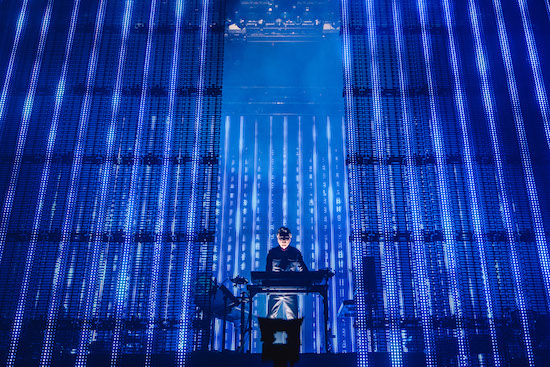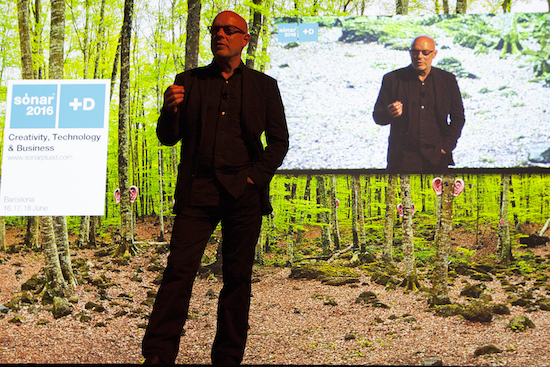If existential festival angst calls, then Eno has you covered
Early afternoon on the first day of a festival is probably a little early to be getting existential dread. But just in case Thursday afternoon at Sónar saw you wondering what on earth you were doing enjoying three days of music and sunshine in a Brexity Trump world, Brian Eno’s Inaugural Conference had your back. “I want to convince you that the only way we can continue to co-operate and work together as human society is with lots and lots of culture and art,” Eno told a sizeable crowd, seated in the enviably air conditioned SonarComplex. And convince us he did, via an impressively wide-ranging 45-minute talk that took in everything from Charles Dickens to the prison system in the US and lesbian plot lines in soaps.
The general thrust of his argument was that humans have become so specialist in our knowledge that we are ever more reliant on community for our daily needs and these communities can be brought together by the arts. And what is art? “Art is everything we don’t have to do,” Eno explained. “Art is for adults what play is for children. Children learn through play. Adults learn through art.” Amen to that – an excellent way to kick off three solid days of advanced adult learning.
The value of your BPM can go up and down
The first law of mixtapes states that BPMs must generally build towards a rousing climax; at Sónar, however, this collides against festival directive 352, which states that the larger names play later. The result is a cheerfully wonky mix of musical programming, which saw Catalan producer Cauto treat the SonarVillage outdoor marquee to some ferocious techno and tearing drum and bass at 3 o’ clock on Thursday afternoon, before giving way to the more horizontal viewpoint of The Spanish Dub Invasion (featuring Mad Professor), who themselves prove the age-old festival edict that if you play Bob Marley covers in the sun, the crowd will smoke itself into an amorous stumble. It’s a slightly discombobulating shift in musical tone, rather like your drunk uncle on the iPod over Christmas dinner, but illustrates the admirable breadth of the Sónar programme.
Lloret Salvatge proves there’s more to Catalonia than John Talabot
The upper reaches of the Sónar bill may be dominated by international names, but the festival is also a great place to catch up on Catalan talent. Attendees undaunted by hangovers from Thursday night had good reason to arrive early on Friday afternoon, when Lloret Salvatge (aka Quim Font) kicked off the day’s programming with an ominous and enveloping ambient set in the darkened SonarHall. Prior to the festival, Sónar co-directors Enric Palau and Ricard Robles had both tipped Lloret Salvatge as one of their most eagerly anticipated shows, and they turned out to be right.
Font lives in Barcelona but hails from the small Catalan city of Vic, and much of his project initially seemed geared toward local concerns: The estelada vermella, a flag with Catalan separatist connotations, hung from his laptop table, and even his project’s alias – Lloret de Mar is a coastal town inundated by package tourists, and "salvatge" means "savage" or “wild" – suggests polemical overtones. After an ear-flaying introduction pitched somewhere between Merzbow and Raster-Noton, however, his set burrowed into more contemplative and even melancholy modes, with scraps of field recordings woven into patient chords and shimmering drones. At times it recalled Succour-era Seefeel without the dub underpinnings; elsewhere, distant echoes of Helm’s Olympic Mess were audible, and at one point, as bouncing kick drums triggered a blippily kinetic passage, you could even detect affinities with Mark Fell and SND. Such rhythmic material may be a new direction for the artist; his debut album, last year’s Humitats, restricts itself to shadowy suggestion and understated murmur. It is an album rich in hypnogogic potential. And so too was Lloret Salvatge’s Sónar set: Most of the crowd in the SonarHall lay flat on their backs. If you’d been in search of an early afternoon battery recharge, you couldn’t have found a more inviting soundtrack for it. (Philip Sherburne)

Just being a legend isn’t quite enough
When Jean-Michel Jarre was named as one of the headliners for Sónar 2016, the reaction was one of bewilderment followed by slow acceptance, as the notion that Jarre was a rather cornball headliner for a forward-looking festival gave way to the realisation that the Frenchman is, in fact, a true pioneer of electronic music, irrespective of whether your mum likes him or not.
In the end, JMJ’s headline show proved underwhelming, although it wasn’t for a lack of trying: the light show was spectacular, Jarre wheeled out ‘Oxygène Part 4’ (aka the one that everyone knows), the laser harp and Edward Snowden (in video form) and exhorted the crowd to have its very best time, bellowing like a middle-aged jungle MC. But nothing really connected emotionally – it was all sleek chrome surface and no beating heart – and the relatively small crowd seemed subdued.
New Order, occupying a similar legends slot on the Saturday night, proved a very different beast indeed. In 2012, freshly reformed, they headlined Sónar with a devastating, 5/5 performance of solid gold hits and not a sniff of new material. It was utterly brilliant – but to do the same in 2016 would have been to give in entirely to the pungent whiff of nostalgia.
It was lucky, then, that the band had Music Complete up their sleeve. Music Complete may have been one of the highlights of last year but to see songs like ‘Plastic’, ‘Restless’ and (especially) ‘Tutti Frutti’ hold their own against ‘True Faith’, ‘Temptation’ et al really brought home what a career renaissance the new album was. And if you’re feeling cynical about the band ending their set with ‘Love Will Tear Us Apart’ (again), then 10,000 Catalans who absolutely lost their mind would like to have a word.
So great are New Order, in fact, that I miss all but 10 minutes of DJ EZ, whose set I had been particularly looking forward to. Never mind: those 10 minutes prove so potent – the usual line up of garage-y classic mixed to surgical perfection – that he could have spent the preceding hour playing Soundcloud mixes of the new Kaiser Chiefs’ single and still have be one of the best DJs at Sónar 2016.
Underground Resistance are the perfect blend of man and machine
The live techno set is a difficult skill to master. Go too far towards the machine element of your music and you may sound mechanical and dull; try to instrument up your electronic sounds and you can end up with the horrible sight of a drummer lumpily trashing seven shades of shit out of your pristine electronic beats.
Detroit pioneers Underground Resistance provided a master class in how to get this right at Martini time on the Friday evening (7.10 PM, to be exact): their set starts with DJ Mark Flash mixing up frenetic, thunderous Detroit techno, with the live trio of Jon Dixon, UR founder Mike Banks and De’Sean Jones slowly joining in on keys, saxophone and more keys, swinging the musical mix round towards a more live sound, to the point where the trio are free forming over what sounds like a James Brown loop in a suitably ecstatic fashion.
The live UR sound leans on classic Detroit techno, of course, but with the same infusion of gospel energy and jazz shuffle that marks classic UR tracks like ‘Hi-Tech Jazz’ and ‘Soul Circuits’. They don’t play either of these – more’s the pity – but they do end their set with monumental live takes on ‘Strings of Life’ and ‘Knights of the Jaguar’, which entirely justify the judicious use of the saxophone throughout.
Stormzy has the charisma, Skepta has the songs
Grime had a notable presence at Sónar this year, building on the appearances from Novelist and Skepta in 2015. Skepta was back, this time on the massive SonarPub stage at Sónar by night; Section Boyz played the SonarVillage on Saturday evening, right after an apocalyptic Barcelona downpour, and Stormzy was part of The Warehouse Project’s programming at SonarLab on Saturday night.
A quirk of festival programming means that Skepta’s set overlaps with the start of Stormzy next door, giving us a very neat opportunity to thumbnail compare and contrast the two hottest properties in grime (with apologies to JME, Novelist, Wiley etc). The conclusion – Stormzy has the charisma, while Skepta has the songs. That’s slightly unfair, of course: Skepta has a beguiling stage presence and Stormzy has some fine tracks up his sleeve. But judging by their Sónar performances, Skepta can’t quite recreate the furious ball-of-energy magnetism that Stormzy exudes, while Stormzy doesn’t yet have a song that can destroy a Barcelona dance floor in the same way as ‘That’s Not Me’.
In any case, the real winner here is probably grime itself, which showed again that it can work on the international stage, even if the locals don’t have a clue what the MCs are talking about. We should see more of it at Sónar 2017.


